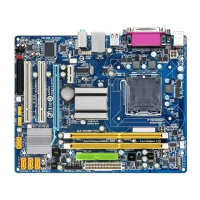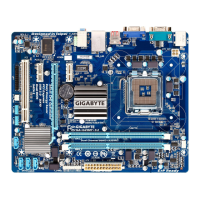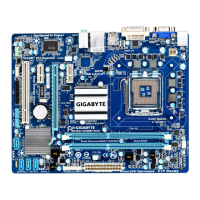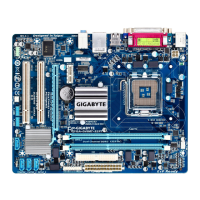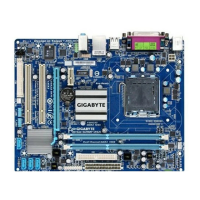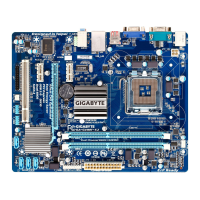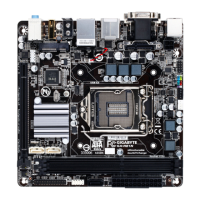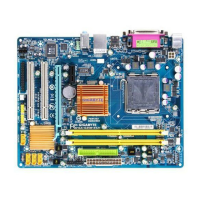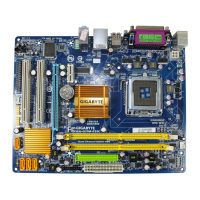Do you have a question about the Gigabyte GA-G41M-Combo and is the answer not in the manual?
Information on how the manual's content is categorized.
Guidance on finding and understanding the motherboard's revision number.
Lists the items included in the motherboard's retail package.
Lists additional accessories available for purchase.
Essential safety guidelines and procedures before installing hardware components.
Detailed technical specifications for the motherboard's CPU, memory, slots, and interfaces.
Step-by-step instructions for installing the CPU and its cooling solution.
Guidelines for installing memory modules and configuring Dual Channel mode.
Procedures for installing PCI and PCI Express expansion cards.
Descriptions and functions of rear I/O ports like USB, LAN, Audio, and PS/2.
Identification and connection details for motherboard's internal headers and connectors.
Overview of the BIOS initial screen and available function keys for navigation.
Explanation of the main BIOS menu structure and navigation function keys.
Settings for CPU, memory frequency, timings, and voltages for performance tuning.
Configuration of system date, time, and IDE/SATA device settings.
Settings for boot order, password protection, S.M.A.R.T. capability, and CPU features.
Configuration options for onboard graphics and chipset specific settings.
Settings for onboard devices like SATA, LAN, Audio, USB, and serial/parallel ports.
Options for ACPI sleep states, wake-up events, and power button behavior.
Resource allocation for Plug and Play (PnP) and PCI devices.
Monitoring system voltages, temperatures, and fan speeds for hardware health.
How to load Fail-Safe or Optimized default settings in the BIOS.
Procedures for setting supervisor and user passwords for BIOS access.
Options for saving changes or exiting the BIOS setup utility.
Step-by-step guide for installing essential chipset drivers using the provided disk.
Overview of included GIGABYTE utilities.
Access to technical documentation and user guides.
Accessing GIGABYTE support contacts.
Viewing basic system hardware and software configuration details.
Links to GIGABYTE's website for driver and BIOS updates.
Links to download newly released software utilities from GIGABYTE.
Utility for system backup and restoration of data on PATA and SATA drives.
Information on updating BIOS using Q-Flash and @BIOS utilities.
Software for fine-tuning system settings, overclocking, and monitoring hardware.
Utility for managing system power consumption and improving energy efficiency.
Tool for convenient data sharing between computers on a network.
Functionality for creating backups of changed data files and copying files from backups.
Feature to enable system power saving using Bluetooth cell phone proximity.
Guide for setting up 2/4/5.1-channel audio and configuring speaker outputs.
Steps to connect and configure a microphone for audio recording.
Instructions on how to record and play back audio using the Sound Recorder tool.
Common questions and answers regarding system startup, BIOS options, and audio issues.
A flowchart to help diagnose and resolve system startup problems.
Information on RoHS, WEEE directives, and environmental recycling guidelines.
Information on how the manual's content is categorized.
Guidance on finding and understanding the motherboard's revision number.
Lists the items included in the motherboard's retail package.
Lists additional accessories available for purchase.
Essential safety guidelines and procedures before installing hardware components.
Detailed technical specifications for the motherboard's CPU, memory, slots, and interfaces.
Step-by-step instructions for installing the CPU and its cooling solution.
Guidelines for installing memory modules and configuring Dual Channel mode.
Procedures for installing PCI and PCI Express expansion cards.
Descriptions and functions of rear I/O ports like USB, LAN, Audio, and PS/2.
Identification and connection details for motherboard's internal headers and connectors.
Overview of the BIOS initial screen and available function keys for navigation.
Explanation of the main BIOS menu structure and navigation function keys.
Settings for CPU, memory frequency, timings, and voltages for performance tuning.
Configuration of system date, time, and IDE/SATA device settings.
Settings for boot order, password protection, S.M.A.R.T. capability, and CPU features.
Configuration options for onboard graphics and chipset specific settings.
Settings for onboard devices like SATA, LAN, Audio, USB, and serial/parallel ports.
Options for ACPI sleep states, wake-up events, and power button behavior.
Resource allocation for Plug and Play (PnP) and PCI devices.
Monitoring system voltages, temperatures, and fan speeds for hardware health.
How to load Fail-Safe or Optimized default settings in the BIOS.
Procedures for setting supervisor and user passwords for BIOS access.
Options for saving changes or exiting the BIOS setup utility.
Step-by-step guide for installing essential chipset drivers using the provided disk.
Overview of included GIGABYTE utilities.
Access to technical documentation and user guides.
Accessing GIGABYTE support contacts.
Viewing basic system hardware and software configuration details.
Links to GIGABYTE's website for driver and BIOS updates.
Links to download newly released software utilities from GIGABYTE.
Utility for system backup and restoration of data on PATA and SATA drives.
Information on updating BIOS using Q-Flash and @BIOS utilities.
Software for fine-tuning system settings, overclocking, and monitoring hardware.
Utility for managing system power consumption and improving energy efficiency.
Tool for convenient data sharing between computers on a network.
Functionality for creating backups of changed data files and copying files from backups.
Feature to enable system power saving using Bluetooth cell phone proximity.
Guide for setting up 2/4/5.1-channel audio and configuring speaker outputs.
Steps to connect and configure a microphone for audio recording.
Instructions on how to record and play back audio using the Sound Recorder tool.
Common questions and answers regarding system startup, BIOS options, and audio issues.
A flowchart to help diagnose and resolve system startup problems.
Information on RoHS, WEEE directives, and environmental recycling guidelines.
| Memory voltage | 1.5 V |
|---|---|
| Memory slots type | DIMM |
| Number of memory slots | 4 |
| Supported memory types | DDR2-SDRAM, DDR3-SDRAM |
| Maximum internal memory | 8 GB |
| Supported memory clock speeds | 800, 1066, 1333 MHz |
| Processor socket | LGA 775 (Socket T) |
| Processor manufacturer | Intel |
| Compatible processor series | Intel® Pentium® |
| Maximum number of SMP processors | 1 |
| USB 2.0 connectors | 2 |
| Power fan connector | Yes |
| Number of Parallel ATA connectors | 0 |
| USB 2.0 ports quantity | USB 2.0 ports have a data transmission speed of 480 Mbps, and are backwards compatible with USB 1.1 ports. You can connect all kinds of peripheral devices to them. |
| Component for | PC |
| Power source type | ATX |
| Motherboard chipset | Intel® G41 |
| Audio output channels | 5.1 channels |
| Motherboard form factor | micro ATX |
| Motherboard southbridge | Intel ICH7 |
| Compatible operating systems | Windows 7/Vista/XP |
| Parallel processing technology support | Not supported |
| LAN controller | Atheros AR8151 |
| Networking features | Gigabit Ethernet |
| BIOS type | - |
| ACPI version | 1.0 |
| BIOS memory size | 16 Mbit |
| Supported storage drive interfaces | SATA II |
| Depth | 210 mm |
|---|---|
| Width | 244 mm |
